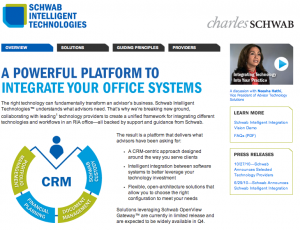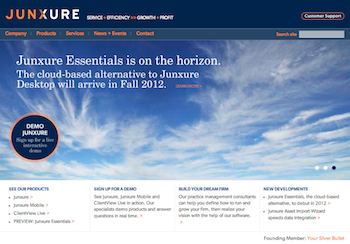| Update 6/21/2011: A bug affected Dropbox’s password authentication mechanism on June 19. Read my follow up post on what advisers need to know about the compromised security. |
Financial advisers want to know: is Dropbox, the simple and convenient file storage service, safe and secure? The answer to that question may not be so clear.
Is Dropbox safe and secure?
Can I store and share client documents on Dropbox?
 I get asked these questions about Dropbox, a simple and convenient file storage service based in the cloud, quite often at conferences and while consulting with financial advisers.
I get asked these questions about Dropbox, a simple and convenient file storage service based in the cloud, quite often at conferences and while consulting with financial advisers.
I’ve discussed Dropbox several times on FPPad (see The iPad for Financial Advisers and Wealth Managers, A Real Life Example of Productivity Tips in Action, and Dropbox Featured in Forbes; Tools Should “Just Work”), but have not specifically addressed security characteristics of the service as they apply to financial advisers and registered representatives.
Frankly, Dropbox’s security attributes of have been a moving target as of late. That’s not necessarily a bad thing for the wildly-popular service, used by more than 25 million people, but it is important that advisers take a close look at how Dropbox communicates regarding its security.
Is It Secure?
I won’t rehash the details of recent controversy over Dropbox’s changes to its statements on security here, but I do want to direct you to a resource that I feel fairly addresses the situation.
Over at TechRepublic, IT consultant Michael Kassner posted an interview with ChenLi Wang of Dropbox’s Business Operations. Read Kassner’s post to gain perspective on Dropbox’s changes to its security statements and how they apply to its users. Click the link below to read it first, then come back and continue reading this post.
TechRepublic: Dropbox: Convenient? Absolutely, but is it secure?
Security Discussion

Flickr: Grey Wind
Now that you have some background on the issue, let’s address security from the financial adviser’s perspective.
Without question, financial advisers collect and maintain personally identifiable information (PII) on clients in order to deliver financial advisory services. Both FINRA and the SEC have requirements in place that FINRA member firms and registered advisers must follow. SEC Regulation S-P, Privacy of Consumer Financial Information, is the primary rule by which advisers must abide to address the protection of client information and records.
With respect to Dropbox, what must advisers do to abide by the requirements?
If you operate under FINRA, you must first ask your broker-dealer’s compliance department what your options are when considering the use of cloud-based applications, including Dropbox. It’s likely your broker-dealer has performed due diligence on a select number of providers which likely include vendors of cloud-based CRM, portfolio management software, financial planning, and document management applications.
Empirically, some broker-dealers have approved the use of services like Dropbox for their registered representatives, while others prohibit its use. So I cannot provide specific guidance for those of you affiliated with a broker-dealer; check with them first.
If you are an SEC or state-registered investment adviser, you must have written policies and procedures in place that address the steps you follow to protect client information. If you elect to use Dropbox, document the steps you take that are designed to (taken directly from Reg S-P):
(i) insure the security and confidentiality of customer records and information;
(ii) protect against any anticipated threats or hazards to the security or integrity of customer records and information; and
(iii) protect against unauthorized access to or use of customer records or information that could result in substantial harm or inconvenience to any customer.
From Kassner’s post highlighted earlier, Dropbox acknowledges that, in “rare circumstances,” a “small number of employees” are able to access user data according to the provisions in Dropbox’s privacy policy (e.g., when legally required to do so). Aside from the rare circumstances, Dropbox’s Wang went on to say:
We have strict policy and technical access controls that prohibit employee access except in these rare circumstances. In addition, we employ a number of physical and electronic security measures to protect user information from unauthorized access.
So let me challenge you, the adviser, with this question: What steps do you have in place to insure the security of client information stored on other web-based services? Have you performed similar due diligence on your CRM provider, online financial planning software, or even your online e-newsletter service? If you feel those services adequately protect the security of client information, how does that align with your confidence in Dropbox’s ability to provide similar protection?
Encryption
Before concluding this post, let’s briefly address the option of using additional encryption. To better protect client information, records can be encrypted using third-party applications before they’re transferred to web-based services like Dropbox (though I know of no methods advisers can use to encrypt client data stored in, say, web-based CRM. Does that make it more vulnerable?).
Remember, Dropbox stated, “all files stored on Dropbox servers are encrypted (AES 256).” Is it necessary to add yet another layer of encryption to files stored on Dropbox? Perhaps. If additional encryption is applied to documents stored on Dropbox, even if the “small number” of Dropbox employees access files legally under “rare circumstances,” all they will see are encrypted files with no meaningful data.
So, yes, the use of third-party encryption such as TrueCrypt, SecretSync, and others mentioned in Kassner’s post, does add an additional layer of obfuscation to protect against information access by Dropbox employees. But does that mean it is required to comply with regulatory requirements?
I believe the answer is no.
Files are already stored encrypted on Dropbox. There’s a reasonable expectation that the files will remain protected from unauthorized access. Assuming select Dropbox employees do access stored files, citing the legal requirement to do so, that access is likely to be authorized, as it is in response to a request from law enforcement. If this were to happen to you, you probably would have more to be concerned about than Dropbox decrypting your files and providing them to law enforcement.
Best Practices
Let me close with what I believe to be best practices for the use of cloud-based storage services, including Dropbox.
If you’re a FINRA member, check with your broker-dealer’s compliance department before using any web-based service. Obtain approval before storing any client information on such services. Also, document your policies and procedures regarding the steps you take to protect client data when using web-based applications.
If you’re an independent registered investment adviser, document the policies and procedures you employ to protect client data when using any web-based service. For added protection, you may optionally apply third-party encryption where applicable, but I believe it is not a requirement to comply with SEC Regulation S-P rules.
Do you have practical information with respect to these best practices? Perhaps your broker-dealer has raised issues on web-based services that are not included here. Please leave comments and feedback below to help clarify what advisers need to do to protect client data stored in cloud-based services.
Full Disclosure: I use Dropbox every day; it significantly simplifies my life. I store both personal and company files on the service. However, I am neither SEC or state-registered nor am I a FINRA member.
For those files that contain private or sensitive information, like social security numbers and bank account numbers, I add individual file password protection. All of these files are in PDF format, so I use Adobe Acrobat to encrypt all document contents with 256-bit AES and require a password to open the document.
Even Adobe PDF document passwords are not a 100% guarantee against unauthorized access. No password-based security system is. But with a combination of mixed case, numbers, and punctuation, the time required to apply a brute-force attack to crack the password may deter unauthorized users from an attempt, and instead seek out more vulnerable targets for an attack. I feel that this level of protection is adequate for my personal situation and acknowledge that the benefits of using web-based services like Dropbox are compelling enough to accept the risk trade-off. Your situation may dictate different considerations.



 In the latest edition of their technology report series, FPA and ActiFi today released the “FPA-ActiFi Adviser Technology Reports: Document Management Edition” highlighting eight different software solutions available to advisers. Solutions reviewed include the following:
In the latest edition of their technology report series, FPA and ActiFi today released the “FPA-ActiFi Adviser Technology Reports: Document Management Edition” highlighting eight different software solutions available to advisers. Solutions reviewed include the following:






